
New World Quarantine Page Menu: 1 2 3 4 5 6 7 8 9 Next>>
New World Quarantine During the Golden Age of Piracy, Page 7
History of Yellow Fever, Continued
Yellow Fever in the New World After 1647
A variety of Caribbean and colonial locations are suggested to have hosted yellow fever outbreaks during the seventeenth and early eighteenth centuries. Henry Rose Carter explains that after the first widespread
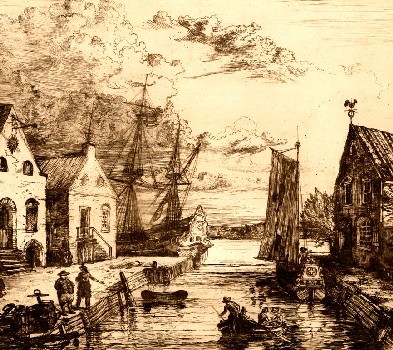
Artist: William Henry Wallace - New York Canal in 1704 (19th Century)
outbreak of 1647-9 in the New World, "we find, in immediately succeeding years, fairly frequent
mention of epidemics" in Mexico and the Caribbean region.1 This actually creates a new problem for determining when and where yellow fever outbreaks occurred; they were so common that the contemporary literature fails to mention them as significant. As one historian says, "From 1688, the illness seemed to spread throughout America and to establish its empire there in a fixed manner almost without interruption. If we do not quote [the dates of] each period, it is because the doctors did not collect them all"2.
In addition, the imprecise period descriptions of waves of illnesses continue to make the positive identification of the virus during the period of interest very challenging. For example, John Blake points out, "it has often been said that New York had a yellow fever epidemic in 1668, and possibly it did. However, the universal source for this statement appears to be Noah Webster's Brief History of Epidemic and Pestilential Diseases."3 The relevant part of Webster's entry reads: "In 1668... [there were] malignant Diseases in America. In New-York the epidemic was so fatal, that a fast was appointed in September, on that account. This was undoubtedly the autumnal bilious fever in its infectious form."4 (Webster's reference to regularity of 'the autumnal bilious fever' does appear to refer back to his description of a 'pestilential fever' which raged in America and the West Indies in 1647 - a year when many historians agree that there was a widespread outbreak of yellow fever in the Caribbean.5 However, both descriptions are too vague and Webster's knowledge of the New World illnesses are self-admittedly insufficient to use this as a credible indication of yellow fever.)
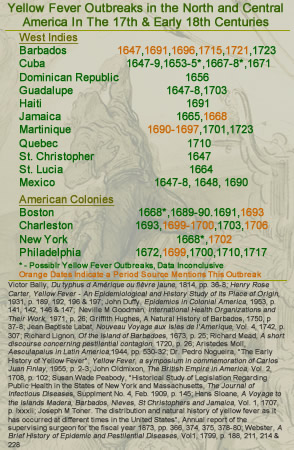
Background Image Artist: Gustav Dore (1898)
Yellow Fever Outbreaks in North and Central America in
the 17th& Early 18th Centuries
With these things in mind, a list of those instances of yellow fever mentioned in various sources is found in the chart at right. Given the uncertainty of identification, the dates in this chart must be viewed with some caution. Those which come from period descriptions of a fever judged to be yellow fever after the fact are shown in orange text. The place/date combinations which are particularly difficult to accept based on their limited source information have a * placed after them and should be regarded as potential, but uncertain, yellow fever outbreaks. The remaining dates and locations come from historians writing after the fact about epidemics which are found in a variety of sources which are generally considered reliable.
Several period sources provide interesting descriptions of the epidemics which occurred in some of the locations found in this chart that are worth looking into. English physician Hans Sloane toured the Caribbean in 1687-8 and in the book he wrote about the journey, he noted that, "When the English under the Command of Sir Henry Morgan, came from Porto Bello, and Panama, (which places they had taken) after certain contagious Fevers, they, for the most part, fell into the Yellow-Jaundice, grew worse and died of it, after languishing a great while in the greatest Degree of it, which is commonly call’d the Black-Jaundice."6 Morgan would have returned from Porto Bello in 1668 when Sloane was on the island. His description features both the yellow color which some people suffering from yellow fever and the name Black-Jaundice which likely arose out of the Spanish term for the disease - Black Vomit.
Although Brazil is in South America (and so not mentioned in this chart), Jesuit priest
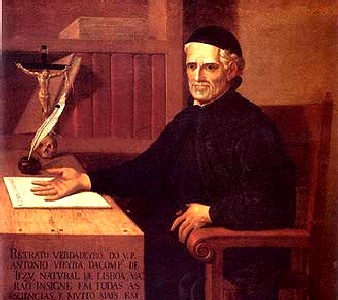
Padre Antonio Viera (Early 18th Century)
Antonio Viera provided a first hand account of the illness's entry into Bahia, Brazil during 1686 in his letters. In a missive to the Count of Castanheira of July 1st he says that "since April this part has suffered a new kind of plague, never seen or understood by doctors, of which two people have already died. The seafarers have done a lot more damage"7, indicating that he recognized that the sailors had brought the illness in with them. He goes on to list a variety of important people who succumbed to the illness.
In another letter sent four days later, Viera explains, "because with the spread of infection, the streets of the city became depopulated, not only from twenty to thirty people dying every day, but because there was no home in which there were not many sick people, and in some homes all were sick."8 Portuguese physician J. Ferreyra de Rosa provides a more clinical description of another outbreak in Oliode, Brazil between 1687 and 1694, likely stemming from the outbreak in Bahia.9
The next period description of an outbreak in this area comes from Dominican priest

Jean-Baptiste Labat, From Nouveau Voyage aux Isles de l'Amerique,
vol. 1, Frontispiece (1722)
Jean-Baptiste Labat, who lived on the island of Martinique between 1693 and 1706. He notes that the fever was "brought there [Martinique] by the King's vessel, named the Oriflame, which [was] returning from Siam after our rout in that country"10. French navy surgeon and author Laurent-Jean-Baptiste Berenger-Feraud fills in some of the details, noting that in December of 1690, "the Oriflamme arrived at Fort-de-France and anchored in the bay of the windward careenage of Fort Saint-Louis and in the middle of the other ships, without being bound by any sanitary measure"11. He suggests that the crew was sick with yellow fever and it spread from them to the population in Fort-de-France based on Labat's information. Labat describes the fever as having acute pains and fever, killing those who succumbed to it in three or four days. "One cannot imagine the disorders it caused in the Isles and on the coasts of the mainland of new Spain, and how many thousands of people it took away."12
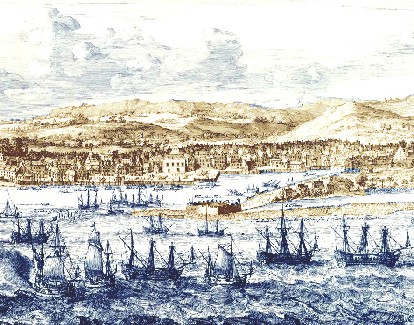
Artist: Samuel Copen - Ships at Bridgetown, Barbados (1695)
Writing about the history of Barbados, John Oldmixon says that in 1691 an English fleet brought 'a pestilential Fever', which infected the whole Island, killing "above a third part of its Inhabitants"13. While the description of the illness is rather vague, it is partially proved by another account discussed in the next section. He gives an unusually broad period for the epidemic of twelve to thirteen years, which means it would have been present on the island between until 1703. In fact, Barbados governor Francis Russell is noted to have died in August, 1696 "of the pestilential fever, which has long raged here, and it may be feared (if God withdraw it not) will lay the Island desolate."14
Historian John Duffy talks about yellow fever being present in Francis Wheeler's fleet, which victualled at Barbados in 1693 before attempting a failed assault on Martinique. Wheeler's fleet then sailed for Boston, bringing yellow fever with it. In July of 1693. Reverend Cotton Mather recorded this epidemic in his Diary.
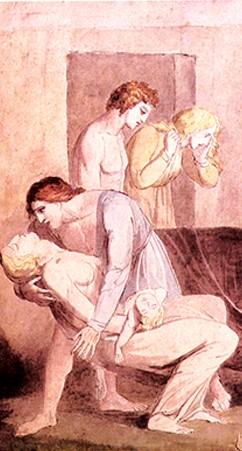
Artist: Samuel Copen - 'Pestilence' (c. 1784)
In the Month of July a most pestilential Feaver, was brought among us, by the Fleet coming into our Harbour from the West-Indies. It was a Distemper, which in less than a Week's time usually carried off my Neighbours, with very direful Symptoms, of turning Yellow, vomiting and bleeding every way and so Dying; tho' for diverse Dayes after the first Decumbiture [forcing the patient to his bed due to illness], the Disease did but as it were play with the Sick.15
In proving that yellow fever may have made the journey with Wheeler's fleet, Duffy points out that the Aedis aegypti mosquito "could easily survive the passage from the West Indies in the summer, and the masses of soldiers and sailors crammed into the British vessels would supply an ample number of hosts to keep the infection in circulation."16
These outbreaks were part of a widespread epidemic which occurred during the last decade of the 17th century. In discussing the history of yellow fever, French physician François-Victor Bally observed that the outbreak started in 1688, spreading throughout the Americas "in a fixed manner and almost without interruption."17. The number of possible epidemics occurring between 1688 and 1703 in the Yellow Fever Outbreaks chart above bear this out.
The turn of the century proved particularly devastating for the North American Colonies. On arriving in his home town of Philadelphia on July 15, 1699 after travelling the countryside, Quaker Thomas Story wrote that he found "many Friends on their sick and dying Pillows". The next day, he added, "In this Distemper had died six, seven, and sometimes eight [people] a-day, for several Weeks together; and the Yearly Meeting [of the Quakers] being to begin there [Philadelphia] next Day, we had some Exercise and Consultation about it, arising from the Prevalency of the Distemper in the City at that Time; and yet not much in the Country."18
Pennsylvania merchant Isaac Norris wrote in autumn of the same year that the illness was
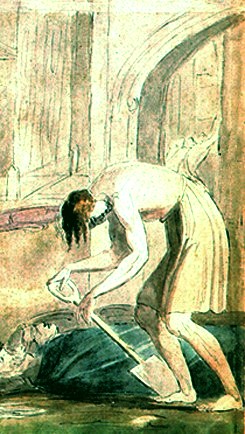
Artist: Samuel Copen - 'Pestilence' (c. 1784)
quite the Barbadoes distemper - they void and vomit blood. There is not a day, nor night has passed for several weeks, but we have the account of the death or sickness of some friend or neighbor. It hath been sometimes very sickly, but I never before knew it so mortal as now: nine persons lay dead in one day at the same time: very few recover. All business and trade down.19
According to historian Duffy, about 220 people died in Philadelphia during this epidemic of an estimated population of 4400 - or about 5% of the population.20
Other communities suffered as well. In January of 1700, the governor and council of Charlestown, Carolina wrote of
a most infectious pestilential and mortal distemper (the same which hath always been in one or more of his Majestys American plantations for eight or nine years last past) which from Barbados or Providence was brought in among us into Charles Town about the 28th or 29th of Aug. last past, and the decay of trade... thereby. This distemper from the time of its beginning aforesaid to the first day of November killed in Charles Town at least 160 persons.21
The same month, Hugh Adams wrote this grim account of Charleston in 1699:
there died in Charlestown, 126, English of all sorts; high and low; old and young. 87, French. 16, Indians, and 1 Negro. … the Distemper raged, and the destroying Angel slaughtered so furiously with his revenging Sword of Pestilence, that there died (as I have read in the Catalogue of the dead) 14. in one day, Sept 28 and raged as bad all October: So that the dead were carried in carts, being heaped up one. upon another. Worse by far than the great Plague of London, considering the smallness of the Town. Shops shut up for 8 weeks; nothing but carrying Medicine & digging graves, carting the dead; to the great astonishment of all beholders.22
Duffy says that the total population of Charleston at this time was unknown, although Oldmixon estimated it at 3000 people, which would result in a fatality rate of about 7%.23

The Seal of the Society for the Propagation of the Gospel in
Foreign Parts (1712)
In 1702, yellow fever struck New York. John Bartow, a missionary for the Society of the Propagation of the Gospel in Foreign Parts (SPG) said in September of that year that it was then "a very mournfull town there dyeing near 20 Persons dayly for some Months."24 By November, another missionary said that although the recent outbreak had been 'mortall' to the citizens, it was free of the disease by the time he arrived. Duffy reports that 570 people died in this outbreak, which he estimates to have been around 10% of the population, although he again notes that the total number of people living there was not known with certainty.25
Yet another SPG missionary, Gideon Johnson, said that upon reaching Charleston in September of 1706, "we found [it] visited with a Pestilential Fever very mortal especially to fresh Europeans;… The French and the Spanish chose this opportune time to attack the city but were driven off by Governor Nathaniel Johnson, who quartered his troops a half mile from the city to avoid the infection."26 The official contain a letter which explained that in August of 1706, "a grevious pestilence, which raged cheifly in Charles Town, took off a great many of the inhabitants, and begann to spread throughout the whole Province, which misfortune comeing to the knowledge of our enemies encouraged them to conclude that now was the only time to execute their designs ag[ains]t us". It goes on to explain that the troops were sent a quarter mile from the town "in order not to expose them... to the sickness of the Town."27 However, these descriptions of the illness at New York are far too vague to verify that yellow fever was the culprit.
Historian Bally says that the fever was also rampant in Martinique in 1701, although he doesn't give a period source for this. He also notes, "The English having disembarked at Guadeloupe in 1703, their soldiers and their sailors were devoured by yellow fever, and the same death spread over the squadron which attacked Martinique around this time."28 Here again there is some mention of this in the official records; Jamaica governor Thomas Handasyd received some soldiers who were originally sent to Guadalupe, but he complained that "they were left [to] us in a miserable condition, many of them being very sickly"29. This is again too vague to being to prove the illness was yellow fever.
In his History of Barbados, reverend Griffith Hughes mentions that a Dr. Gamble (possibly Joseph Gamble), told Hughes that he remembered the island being
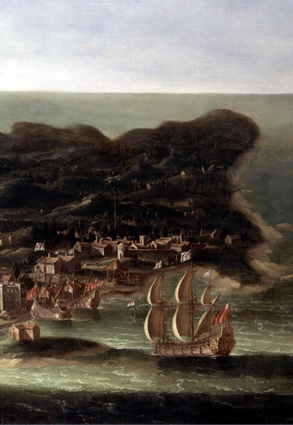
Artist: Isaac Sailmaker- The Island of Barbados' (c. 1694)
very fatal ...in the Year 1691. and that it was then called the New Distemper, and afterwards Kendal's Fever, the Pestilential Fever, and the Bilious Fever: The same Symptoms did not always appear ...It is most commonly rife and fatal in May, June, July, and August; and then mostly among Strangers, though a great many of the Inhabitants, in the Year 1696. Died of it, and a great many at different Periods since.30
He adds that the symptoms reappeared in 1715.31 Unfortunately Dr. Gamble's recollections do not include a more extensive description of the illness and we are once again left with only an impression that the illness there might have been yellow fever. However, given that the island had apparently been the repeated site of yellow fever outbreaks and that it was the first location touched at by many ships coming from Africa, it is probable that yellow fever was the illness in some, if not all, of these cases.
Writing in 1741, doctor Henry Warren said that 'a plague' was present on Barbados in 1721, "generally thought to be introduced among us from Martinique, in the Lynn Man of War, and Committed much Ravage here for two Years or more."32 Warren notes that the illness was called La Maladie de Siam by the French and "sometimes they call it La Fievre Matelotte, because Sea-faring People and New-comers are chiefly obnoxious to it; and probably it is the very same Fever, which the Spaniards call Vomito Preto, or the Black Vomiting, from one of its most dire Symptoms."33 Of course, this is yellow fever based on our modern understanding of the disease.
Although this section only highlights the dates for which some period sources were uncovered, it is quite possible that any of the other dates shown in the chart above may have been yellow fever. After 1647, the disease seems to have become more widespread in the Americas, being moved around by mosquitos, imported slaves and sailors on ships coming from infested areas in Africa and America.
1 Henry Rose Carter, Yellow Fever - An Epidemiological and Historical Study of Its Place of Origin, 1931, p. 56; 2 Victor Bally, Du typhus d Amérique ou fièvre jaune, 1814, translated by the author, p. 34-5; 3 John B. Blake, "Yellow Fever in Eighteenth Century America", Bulletin of New York Academy of Medicine, June 1968, p. 673; 4 Noah Webster, A Brief History of Epidemic and Pestilential Diseases, Vol. 1, 1799, p. 203; 5 Webster, p. 188; 6 Hans Sloane, A Voyage to the Islands Madera, Barbados, Nieves, St Christophers and Jamaica, Vol. 1, 1707, p. lxxxii; 7 Antonio Viera, "Carta C. Ao conde da Castanheira", Cartas do padre Antonio Vieira, 1854, Translated by the Author, p. 147-8; 8 Viera, "Carta CIII. A Diogo Marchao Themudo", p. 151; 9 Victor Bally, Du typhus d Amérique ou fièvre jaune, 1814, p. 31-2; 10 Jean Baptiste Labat, Voyage du chevalier Des Marchais, 1731, Translated by the Author, p. 5-6; 11 Laurent-Jean-Baptiste Berenger-Feraud, De la fièvre jaune à la Martinique, 1878, p. 4; 12 Labat, p. 6; 13 John Oldmixon, The British Empire in America, Vol. 2, 1708, p. 102; 14 CSPC America and West Indies, Vol. 15, Item 193; 15 Cotton Mather, The Diary of Cotton Mather 1681-1724, 1911, p .166-7; 16 John Duffy, Epidemics in Colonial America, 1953, p. 141; 17 François-Victor Bally, Du typhus d Amérique ou fièvre jaune, 1814, Interpreted by the author, p. 34-5; 18 Thomas Story, A Journal of the Life of Thomas Story, 1747, p. 223; 19 John Fanning Watson, Annals of Philadelphia and Pennsylvania in Olden Time, 1844, p. 370; 20 Duffy, p. 145; 21 Frederick Dalcho, An Historical Account of the Protestant Episcopal Church in South Carolina, 1820, p. 36; 22 Samuel Sewall, Diary of Samuel Sewall, Vol II, 1700-1714, 1879, p. 11-2; 23 Duffy, p. 144; 24 Duffy, p. 145; 25 Duffy, p. 146; 26 Duffy, p. 147; 27 CSPC America and West Indies, Vol. 23, Item 517.i; 28 Bally, p. 37; 29 CSPC America and West Indies, Vol. 21, Item 888; 30 Griffith Hughes, A Natural History of Barbados, 1750, p. 37; 31 Hughes, p. 38; 32 Henry Warren, A Treatise Concerning the Malignant Fever in Barbados, 1741, p. 4; 33 Warren, p. 3-4
Golden Age of Piracy Sailors and Yellow Fever
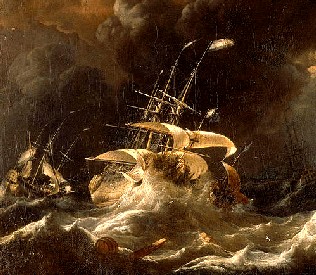
Artist: Ludolf Bakhuisen
Dutch Merchant Ships in a Storm (late 17thc.)
Henry Carter makes a point of explaining that yellow fever can be caught ship board, unlike other illnesses such as malaria.1 The Aedes aegypti mosquito requires standing water to breed and wooden sailing vessels during this period provided it. "Drinking-water in artificial containers, accessible to the mosquito and in proximity to man, make such a vessel well-nigh an ideal breeding place for aegypti and, seeded at some port in which the species existed, the vessel, thus acting as a host, would carry them to other ports."2 In addition, water in a vessel could collect in the hold of a ship, providing another location for a mosquito to breed, particularly in older vessels.
Various sources repeatedly note that navy fleets brought yellow fever with them in this way. The 1693 outbreak caused in Boston by Francis Wheeler's fleet following their failed attempt to attack Martinique mentioned in the previous section is an example of this. Medical historian John Blake explains:
\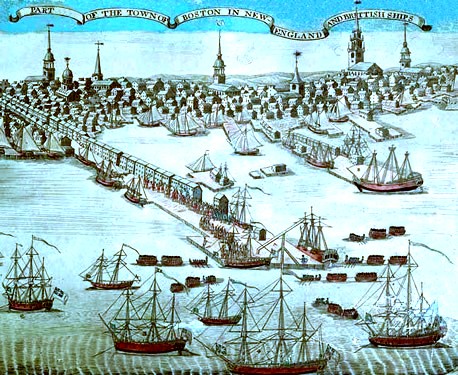
Artist: Paul Revere - British Ships in Boston Harbor (1770)
sickness among his troops, added to French resistance, forced Wheeler to withdraw. He sailed for Boston, planning now to join the New Englanders in an attack on Canada. By the time he reached Boston, he had lost over half his command, partly, at least, from yellow fever. The Massachusetts governor attempted to isolate the English forces but without success, and during July several deaths occurred among the townspeople. Soon after, Wheeler sailed for England, and in the fall the epidemic disappeared.3
Since yellow fever was not identified during this period, determining whether particular period sailors accounts refer to it being contracted by them is challenging. However, there is one which very likely refers to sailors catching the virus and that comes from merchant captain Thomas Phillips, who stopped at Barbados in November of 1694. It is notably land-based rather than account of the fever occurring at sea.
When Phillips arrived, he said that Barbados was "violently infected with the plague, so that in the late war it proved a perfect grave to most that came there, all new-comers being generally seiz'd with the pestilence; of which very few recover'd."4 Despite the name he gave to the illness, no plague epidemic has even been identified as occurring in Barbados. Among the men that Phillips lost to the fever in Barbados was his surgeon, which proved to be a problem for him when he came down with convulsions and vertigo at sea six months later.5
As mentioned in the previous section, Barbadian John Oldmixon \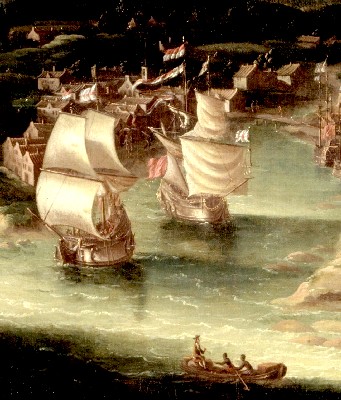
Artist: Isaac Sailmaker
Ships in the Harbor at Bridgetown, Barbados (1694)
suggested that between 1691 and 1702 or '03, yellow fever was rampant on the island.6 His dates neatly bracket Phillips' visit and suggest the presence of yellow fever there before his arrival.
Phillips was not the only captain to suffer mortality at the hands of the illness on Barbados. He notes that "Capt. Thomas Sherman, in his majesty's ship Tiger, in [the] two years that he lay there, bury'd out of her 600 men, as he told me, tho' his complement was but 220, but still pressing new [men] out of the merchant ships that came in, to recruit his number in the room of those that died daily."7 Eighteen of Phillips' merchant sailors died along with "20 masters of ships during my stay here; of which number were poor Capt. Gurney and Bowls, that commanded his majesty's ships Bristol and Play-prize."8 The Bristol was a fifty gun 4th rate ship of the line specifically commissioned for the West Indies commanded by Edward Gurney. The Play Prize was a captured French warship converted into a 30 gun fifth rate which was commanded by Edward Bowles.9
One other sailor's account could have been a description of a man on a ship from yellow fever, although there is much room for doubt. Captain Francis Rogers describes the death of a gunner's mate John Sharp in June of 1704 by what he said was probably poison given to him by a woman in Surat, Africa. Yet the description of the man's symptoms sound in many ways like yellow fever. "Beginning to dwindle when he left Surat, and continuing to decay and daily waste away, perceivable turning more yellow as he grew nearer his death, his nails loosening and hair (to the best of my remembrance) and became extremely yellow before his death."10 Rogers also mentions that the man was 'sensible to the last' which, when combined with loosening of the nails and hair, sounds like something other yellow fever.
1 Henry Rose Carter, Yellow Fever - An Epidemiological and Historical Study of Its Place of Origin, 1931, p. 71; 2 Carter, p. 24; 3 John Blake, "Yellow Fever in Eighteenth Century America", Bulletin of New York Acadamy of Medicine, June 1968, p. 674; 4,5 Thomas Phillips, “A Journal of a Voyage Made in the Hannibal of London, Ann. 1693, 1694”, Churchill’s A Collection of Voyages and Travels, Vol. VI, p. 237; 6 John Oldmixon, The British Empire in America, Vol. 2, 1708, p. 102; 7,8 Phillips, p. 237; 9 "British Fourth Rate ship of the line 'Bristol' (1693)" & "British Fifth Rate frigate 'Play Prize' (1689)", threedecks.org, gathered 2/11/19; 10 Francis Rogers. from Bruce S. Ingram's book Three Sea Journals of Stuart Times, 1936, p. 19

